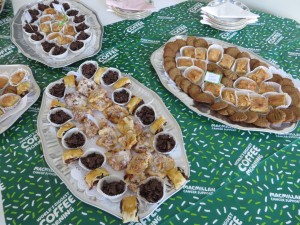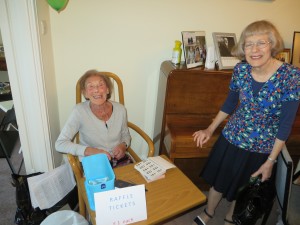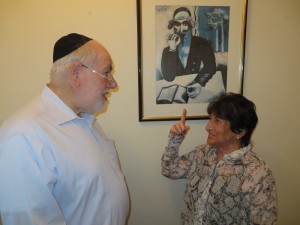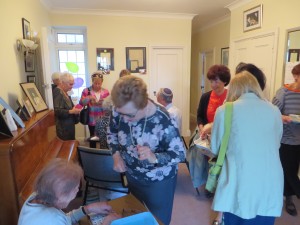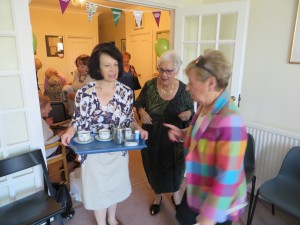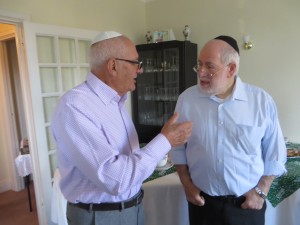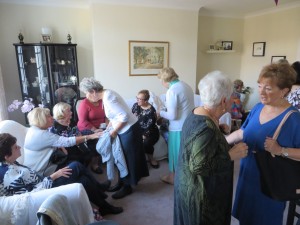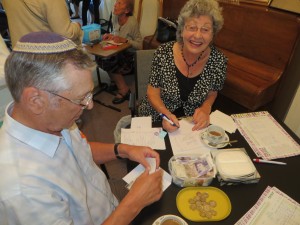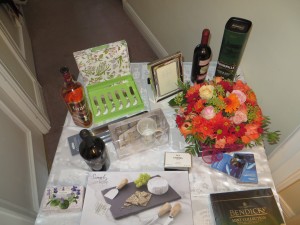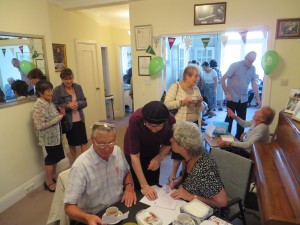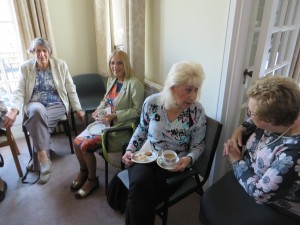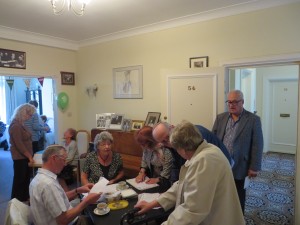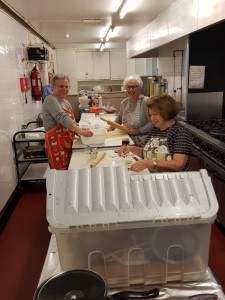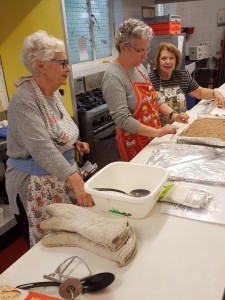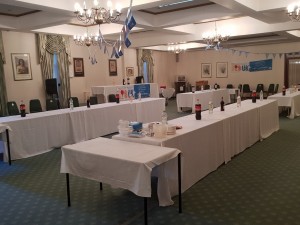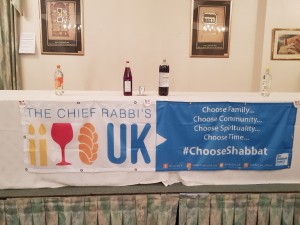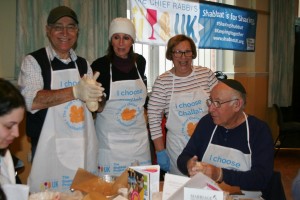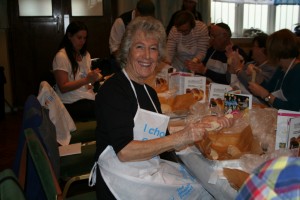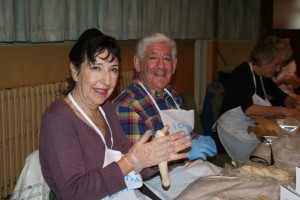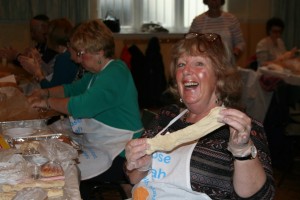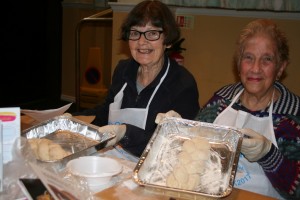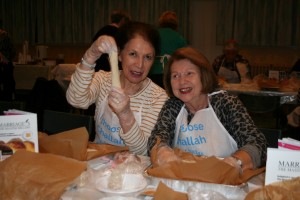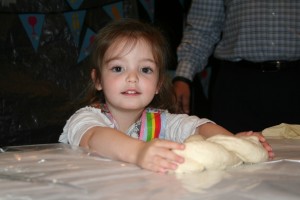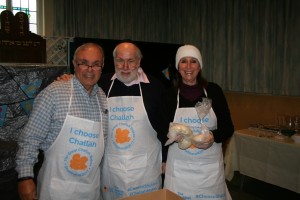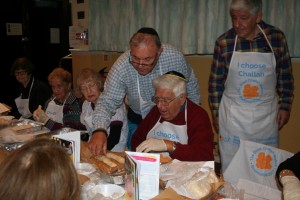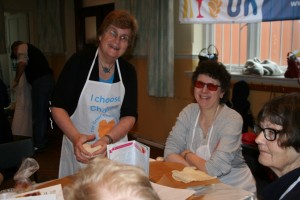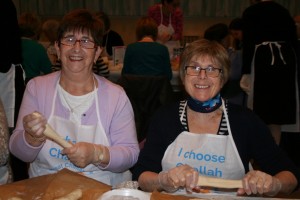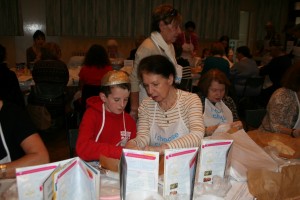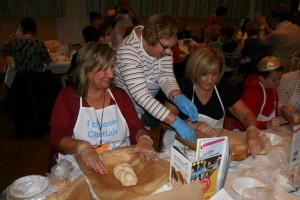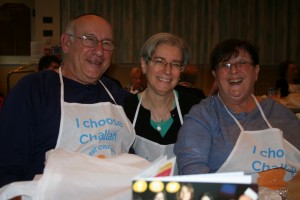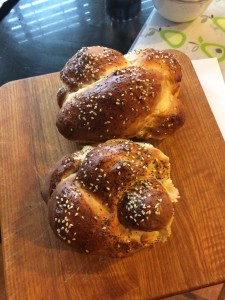This is a transcript of the presentation made by Vivien and David Harris at the recent Tikun Leyl Shavuot. It tells of Vivien’s father‘s family. We felt it would be of interest to the wider community. We would like to thank Vivien and David for their kind permission to publish their story on our website.
DAVID
I’d like to begin by thanking Richard and others for this opportunity. It so happens that, on the second day of Shavuot, I have yahrzeit for my mother, so I’d like to share these few words in the memory of Marat Leah bat Ze’ev, alehah ha’shalom.
Reb Shmuel of Nickolsburg, or to give him his more popular name, Reb Shmelke, was a major figure in the early days of the Chassidic movement. It happened that he was once travelling home by sea, together with one of his close disciples, Reb Moshe Leib of Sasov. A violent storm suddenly broke out and whipped up the waves. The travellers were terrified and cried out to God, desperate for deliverance. In the middle of all of this, Reb Shmelke was amazed to see his disciple, Reb Moshe Leib sitting in a corner, singing simcha melodies.
“Moshe Leib”, he said. “What are you doing? At a time like this, how can you be so happy?”
Said Reb Moshe Leib “As Yaakov Avinu, our forefather Jacob, says in Parashat Va’yetze ‘Veshavti b’shalom el bet avi’. ‘I will return in peace to my father’s, i.e. my family’s – home’. How can I not be glad when soon I will be in my family home?” The storm abated and the ship arrived safely at its destination.
Well, Vivien and I, together with other family members, spent a day during the summer of 2011 in Vivien’s father’s home in Seelow, in the former East Germany. Although we flew, rather than going by sea, I’m delighted – and relieved – to report that our journey was hazard-free. But return in peace to a family home we certainly did.
In that same parashat Va’yetze, Jacob promises that if God keeps him safe, “Ha’even ha’zot asher samti matzevah” “I will set this stone” – which has been his impromptu pillow – “as a monument”. As chance would have it, stones and monuments feature in our story, too. But for the moment let me set the scene and tell you something about Seelow.
Seelow is an unpretentious little town of about five and a half thousand souls. It’s situated a fifty-minute train ride east of Berlin towards the Polish border and you can actually see into Poland from Seelow.
Prior to the Nazis’ rise to power, only three Jewish families remained in Seelow, all members of Vivien’s family. There was the Reissner family, comprised of Vivien’s grandparents, Louis and Martha, and their three children Ruth, Willi and Joachim.
Then there were the Philippsborns: Max, his wife, Adelheid, and their son, Heini.
And, finally, the Irmligs: Isidor and Julie, their daughter, Hildegarde, her husband, Karl-Heinz and Isidor’s son, Berthold, from his first marriage.
These three family groups were all related because Louis Reissner, Adelheid Philippsborn and Julie Irmlig were brother and sisters.
As things turned out Willi Reissner, Vivien’s father, and his brother, Joachim, escaped to London where they began new lives. So, too, did their cousin Heini Philippsborn, who settled in Brighton.
Not so for the other family members. Louis and Martha Reissner, Vivien‘s grandparents, were deported to the Warsaw ghetto in 1942 and that is the last information we have of them.
Their daughter, Ruth, Vivien’s auntie, was working in a Jewish orphanage in the Pankow area of Berlin. The last information we have of her is that on 5th September 1942, she, together with the children and other members of staff from the orphanage, were deported from Berlin on Transport 19 to the east, to Riga. There, she, and others on the train, were murdered in the forest immediately on arrival, by the Nazis and/or their Latvian collaborators.
Adelheid Philippsborn was also deported to the Warsaw ghetto in 1942; her husband, Max, had died of a stroke in Seelow in 1940.
Julie and Isidor Irmlig were deported to Treblinka on erev Tisha B’Av 1942. Hildegarde and Karl-Heinz Irmlig were murdered in Warsaw in 1942. Berthold Irmlig was deported to Sachsenhausen where he was murdered in December 1940.
VIVIEN
It so happens that I also have yahrzeit on the second day of Shavuot. My yahrzeit’s for my father who died when I was a teenager.
As far back as I can remember, I’d always wanted to visit Seelow, my father’s home town, although I wasn’t very keen on travelling to the former DDR. However, after the fall of the Berlin Wall, as David said earlier, I actually did. David talked about our visit in 2011 but we – and my brother and sister-in-law had already visited the town two years before that, in 2009.
We’d decided to contact the town hall to enquire whether we could get a train to the town – and thank goodness we did as I’m not sure what we would have done when we got there, if we’d gone under our own “steam”.
Our visit was masterminded by someone called Thomas Drewing. Thomas, who works in Planning at the Town Hall, is a keen local historian and it’s one of the quirks of fate that, had it been someone else who’d received our initial e-mail, we might never have received the same results.
Once we’d made contact, Thomas was able to answer quite a lot of questions about my family and he also sent send us copies of all my family’s birth, marriage and death certificates.
On the day of our visit, we took a very early train, from Berlin to Seelow, and there was a reception party waiting for us at Seelow station (which was just as well, as the station is not in the town but somewhere in the countryside, in the middle of nowhere).
As we drove into Seelow, I felt very emotional and I remember saying “I never ever thought I’d come here”.
We were given a guided tour of Seelow and, from the top of the church tower, I had the first glimpse of my father’s family home. The mayor then came to meet us – and later, someone from the local newspaper.
Before our visit, I’d asked Thomas whether it would be possible to go into my father’s house. This was also something that I’d never expected to do and there was such a lump in my throat when we went inside. Growing up, we’d often heard a story about my grandfather winning the lottery sometime before 1930 and the local historian has since found a newspaper article, confirming this. Apparently my grandfather hid the winnings under the cellar floor. We had a good look at the floor but …….
Thomas also took us to the Town Hall where he’d laid out a family tree of all my father’s family. Later on, we met with three gentlemen who told us what they’d remembered about my family before they were taken away from their home at 20 Berlinerstrasse, the day after Kristallnacht.
Before we arrived, we told Thomas not to worry about meals for us and that we’d be bringing our own food. However, before we left Seelow, one of the other Town Hall staff presented us with a “cake”, together with the recipe, which she’d made. She said that we could eat it on the train back to Berlin. She’d found a “kosher” recipe on the Internet – it was an extremely large challah!
After we arrived back home, I e-mailed Thomas and asked him about the possibility of installing Stolpersteine in Seelow – which David’s going to talk about in a minute. Thomas replied that he already had it in mind. And that brings us to our visit in 2011 but before that….
DAVID
One of the things that survivors of the Holocaust find most painful is that they have no concrete memories of those who did not survive. They have no idea when their loved ones passed away so they can’t light a memorial candle; there’s no yahrzeit to observe. Neither is there any grave side to visit. No one knows where this or that victim of the Holocaust perished.
Enter a word, in German, “Stolpersteine”. “Stolpersteine”, translated into English, means “stumbling stones”; they are small, square, concrete bricks. They have brass memorial plates on the top and are inserted into pavements.
Stolpersteine are meant to draw attention to the fate of those who were persecuted by the Nazis. Financed by donations, the project aims to honour the victims and to rescue their memory from oblivion.
Stolpersteine are different from other memorials. They bring memorial culture down to street level. They are personal, local, a little bit awkward and liable to cause embarrassment.
They’re about who used to live in your house or flat and the inconvenient truth that these people were murdered. They are also about neighbours and raise the awkward question of what kind of neighbour you might have been under other circumstances.
In Germany, Stolpersteine are a phenomenon. They’re to be found in over 500 localities and they record the residence, date of deportation and place where the commemorated person perished. They’re like gold-coloured cobblestones, catching the eye and tripping up the conscience and they are the best-known work of an artist called Gunter Demnig and whenever a Stolperstein is installed, he has to be there to install it. But, Gunter Demnig isn’t Jewish so why did he create these memorials?
You can find the answer to this question in the stylish, opulent villa at Wansee where, in January 1942, Heydrich,Eichmann and their henchmen met to discuss the final solution to the Jewish question. Now a museum, Wansee has a stolpersteine exhibit and in the display case there is a quotation from Gunter Demnig which reads:
“I don’t know, sometimes I try not to think about what my father could have been part of”.
Demnig senior was a member of the German army during the war but never spoke to his son about it. So, in acknowledgement and recognition of what his father may have done, Gunter Demnig has created this method of keeping the memory alive.
Gunter Demnig does not see the Stolpersteine as gravestones, however. He wants them to be walked over, so that their metallic surfaces stay shiny. The victims receive their names and a part of their identity back, so that each personal stone is also intended to symbolise all the victims.
We were told that memorials would be installed outside Vivien’s grandparents’ home- the only one of the three Jewish houses still standing- and also where the Philippsborns and Irmligs – her father’s aunties and their families – had lived.
VIVIEN
Going off at a tangent, for a moment, by a curious coincidence, in October 2010, I’d arranged to visit Auschwitz and, the day before, having recently discovered that my mother’s brother, Heinz, had perished there, I decided to look through what little information I had.
In those dark times, when countries were at war with each other, the only way to communicate with family left behind was via the Red Cross. Relatives who’d managed to escape would write a short message on one side of a form and, if their relatives were still alive, they’d reply on the reverse. Unsurprisingly, it usually took a number of months for a message to get back to the originator.
Prior to September 1939, my mother had lived in Dortmund, in the West of Germany. However, she’d always told me that her brother, Heinz, had been a slave labourer in my father’s home town, Seelow, in the East of Germany.
As I read the Red Cross letters in my file, I came across a reply on the back to one that my mother had written to Heinz in 1941. I didn’t remember noticing this before but Heinz had written that he’d married Elli Stern in Seelow on 26 October that year. So this is how my mother knew about Seelow.
I had a sudden brainwave – and the next minute, an e-mail was winging its way to Thomas Drewing, our contact at Seelow Town Hall, asking if he could possibly trace the marriage certificate for Heinz and Elli. Half an hour later, Thomas replied “I have it and will send it to you within the next half hour”.
Half-an-hour passed and David and I checked our e-mails. Thomas’s reply had arrived and we eagerly opened it to find the scanned certificate of Heinz’s and Elli’s marriage. Thomas had also been kind enough to include a translation of the certificate into modern German, followed by one in English. As we were scrolling through it, I noticed my father’s father’s name on the page.
“Thomas has made a mistake”, I said to David. “He’s got the wrong side of the family”. He’s sent me something about my father’s family, instead of my mother’s family.”
Then I suddenly realised that Thomas hadn’t made any mistake – quite the contrary. The amazing fact was that my father’s father had been a witness at my mother’s brother’s wedding in Seelow.
My parents didn’t meet until after the war and married in London in 1947. But, unbeknown to either of my parents, my father’s father had already met my mother’s brother and sister-in-law, in 1941. How I wish my parents had known about this.
Following this discovery, we were then so pleased to hear that the town of Seelow also intended to install Stolpersteine for Heinz and Elli outside a local community centre called the Schweitzerhaus (the Swiss House), where they’d been married and also for Mathel – their baby daughter – who was born in the winter of 1942. So, it was a coming together of both my parents’ families.
And so it was that on Monday 8 August 2011, corresponding coincidentally and appropriately to erev Tisha B’Av, 14 of us arrived in Seelow.
I have to admit that I found it quite stressful, making arrangements for 14 family members to be in Seelow at the same time, but it was a very important day for us all and, as Thomas later said, it was a very important day for the town too.
Again, we were met at Seelow station and driven to the town. And, it was outside the Irmlig home that the first Stolpersteine were installed Gunter Demnig. Following this, the mayor of Seelow gave a short speech.
We then moved on to the Philippsborn home, then to my family home, where the Stolpersteine had already been installed, and, finally, to the Schweitzerhaus, a few minutes from the town where the Stolpersteine for my mother’s family were installed.
DAVID
At each location Bryan, a member of the Philippsborn family who had travelled from Prague, where he is a chazzan at the Altneu Shul, and I recited yizkor prayers. Vivien’s brother spoke outside their family home and I spoke at the Schweitzerhaus.
We don’t know how they got to know about it but, for the first three installations, we were joined by some young people who were attending a summer camp in Germany, organised by the Janusz-Korczak Academie in Munich.
Before we left the UK, their teachers had asked whether we would mind if they attended. Jewish children from Israel, Germany, the Ukraine, Russia and the USA joined in this occasion and made their own contributions in German, Russian and Hebrew before ending with “Eli, Eli,”-the anthem of the Holocaust – the song of the Hannah Senesh poem, and Hatikvah. They also unfurled an Israel flag.
The young and the not-so-young, all together, from different countries but all remembering the victims among our people. As you might imagine, it was a very special occasion.
VIVIEN
Before the actual day, the town held several events, for the community and for local schools, about the history of Jewish life in Seelow and also about tolerance and diversity.
They also screened a film called The Last Train – a fictional story inspired by the 37th Transport of Jews from Berlin to Auschwitz. In 1943, on the real train, were my mother’s brother, sister-in-law and one-year old niece, Heinz, Elli and Mathel.
I had previously asked Thomas whether it would be possible for me to go into my father’s house again. He said that he would ask, although it might be difficult for all of us to go in. However, at the end of an exhausting day, 11 of us did!
I suppose that now, the most important thing is that the Stolpersteine are there and will be there for many, many years to come, reminding anyone who passes by of the appalling thing that happened, not in some far flung place, but in their home town, in their neighbourhood, in the streets that they know. And they’ll see these reminders every time they go past.
I must admit that I feel a sense of comfort and, well, almost pleasure that every time the occupants of number 20 Berlinerstrasse now go in and out of their house they’ll be reminded of the Jewish family whose home it was and the terrible fate to which most them went.
It also comforts me that this is as near as you can get, to an everlasting memory to the family that I never knew. For most, we’ll never know what their actual fate was. There are no graves to visit and there’s no Yahrzeit to observe. But, they’re in our consciousness and we’ll visit Seelow in the future, knowing that my family is, in some sense, still there.
The visit to Seelow has altered my relationship to my family history. My father never spoke about his family and now I was able to imagine them, not just as numbers in that cold statistic of six million victims, which is beyond all human comprehension.
DAVID
Emeritus Chief Rabbi Sachs points out how remarkable it is that Biblical Hebrew has no word for “history”, despite the fact that three quarters of Tanach is made up of historical narratives. Modern Hebrew has borrowed the word “historiah” for the academic area of study but there is no equivalent in the Biblical language.
Rabbi Sachs goes on to observe that the key word of Tanach isn’t “history” but “memory”. “Zakkor”, the command to remember, occurs time and time again in the Torah. For example: “Remember the Sabbath day to keep it holy”; umpteen religious observances because they are “zecher yetziat mitzrayim”, “in memory of the exodus from Egypt.”
He continues: there is a profound difference between “history” and “memory”. “History” is his story – something that happened to someone else. “Memory” is my story – something that happened to me and is part of who I am. History is information; memory is part of identity.
We can study history but the knowledge we gain makes no claim on us. That knowledge is the past as past. Memory, however, is the past as present, as it lives on in us. Without memory, there can be no identity.
But, there is a problem with all of this. How can we remember what didn’t happen to us – an event that took place before we were born? A way of answering this question is shown in our Seder ritual where, by using symbols and actions, we re-live the events of ancient times. We can apply that model to other matters, too. We need to re-enact the past, to bring the past, with its people, back into our consciousness once again and on this festival of Shavuot we’ll do that tomorrow when we will stand as the events of the giving of the Torah are recalled and re-lived.
Professor Yosef Hayim Yerushalmi was the Director of Israel and Jewish Studies at Columbia University in New York and at the end of one of his books, “Zakhor”, published in 1989, he refers to a poll that the French newspaper, “Le Monde”, had conducted as to whether Nazi war criminal, Klaus Barbie, “The Butcher of Lyons”, should be put on trial. People were asked: “Which of the two words ‘forgetting’ or ‘justice’ best characterizes your attitude towards the events of this period of the war and the Occupation?”
Yerushalmi ponders this option – “forgetting” or “justice”? Seems an odd choice. Shouldn’t it be “forgetting” or “remembering”? “Could it be that the journalists have stumbled across something more important than they perhaps realized?”, Yerushalmi asks. We assume that the opposite of “forgetting” is “remembering?” but could it be, Yerushalmi suggests, that the opposite of “forgetting” is not “remembering”. The opposite of “forgetting” is “justice”.
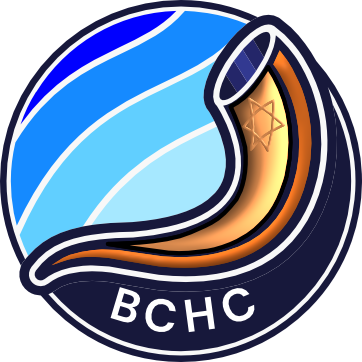


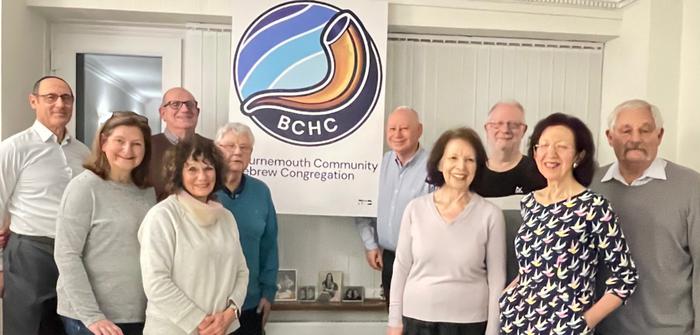
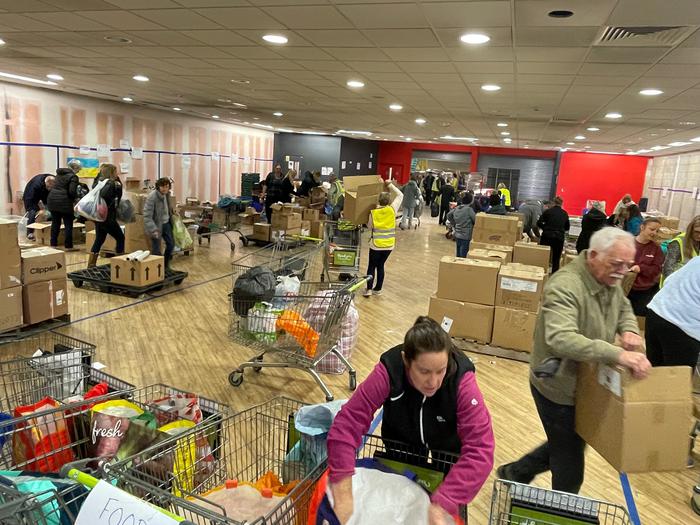
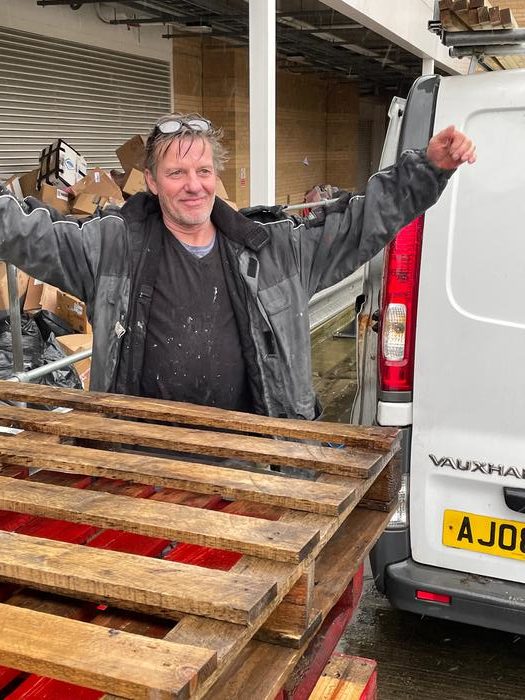 Next, we needed to find a way to get the pallets to the Donation Centre. So, a call went out to our Community and, via contact of a member, a kind volunteer with a van came forward. Cue Mike Pollard!
Next, we needed to find a way to get the pallets to the Donation Centre. So, a call went out to our Community and, via contact of a member, a kind volunteer with a van came forward. Cue Mike Pollard!